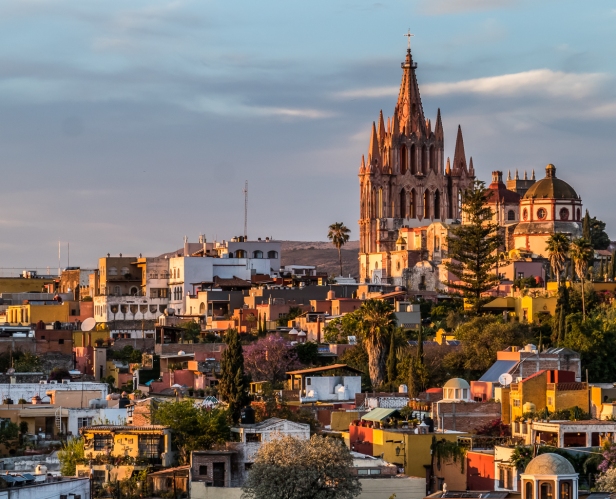
7 Jan – 4 Apr 2016. I’m in the Jardin, San Miguel’s town square, sitting on the low stone wall facing the large space in front of La Parroquia, the parish church. The space is filled with a riot of colour and movement, flashing feathers, flying feet and pounding drums. About thirty dancers from one of the local indigenous tribes are dancing up a storm to a loud rhythmic beat. Their joy and commitment is compelling.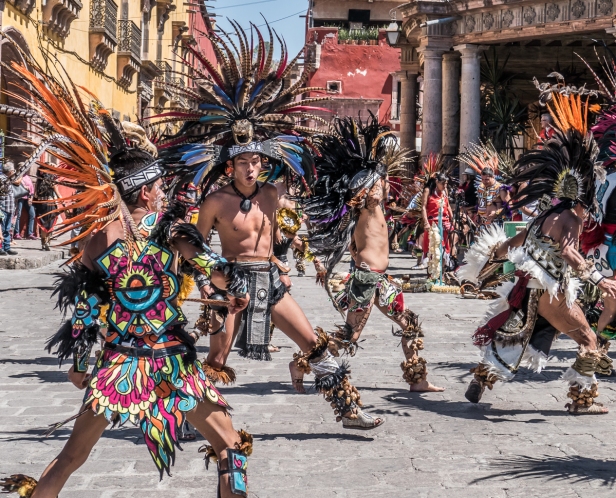
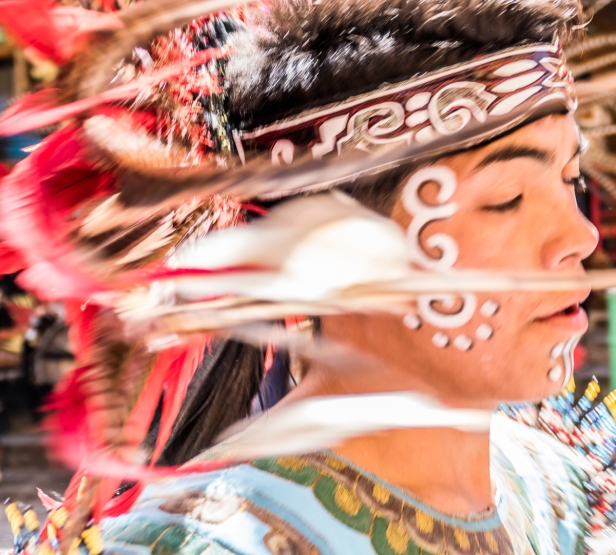
I watch and photograph “death”. His mask is unique: a shiny reflective chrome gaudiness that can’t be ignored, the feathers a mad celebration of orange and blue. He absorbs every bit of my attention. His charisma, his presence, his commitment to the dance is unmistakable. He’s a wild man giving everything he’s got. We connect somehow. Apart from photographing him, maybe he gets my enthusiasm for his vibrant dancing. I’m grinning from ear to ear. He’s death, but he’s not scary, he’s exhilarating!
One of the tassels of beads and feathers falls from his headdress. He scoops it up and presents it to me. Wow! I’m so honoured. I tie it to my camera case, and there it lives. I think of it as a shaman’s gift for my journey. Later when the dance is over he pulls off his mask to reveal his smudged skull face. I am kissed by death. It’s not an omen; it’s a benediction.

The Festival of Our Lord of the Conquest, held each year on the first Friday in March, completely fills the Jardin Principal and the streets adjoining it. There must be at least ten different dance groups. Hundreds of Chichimeca (a collection of different individual tribes) or conchero dancers come in from the surrounding towns.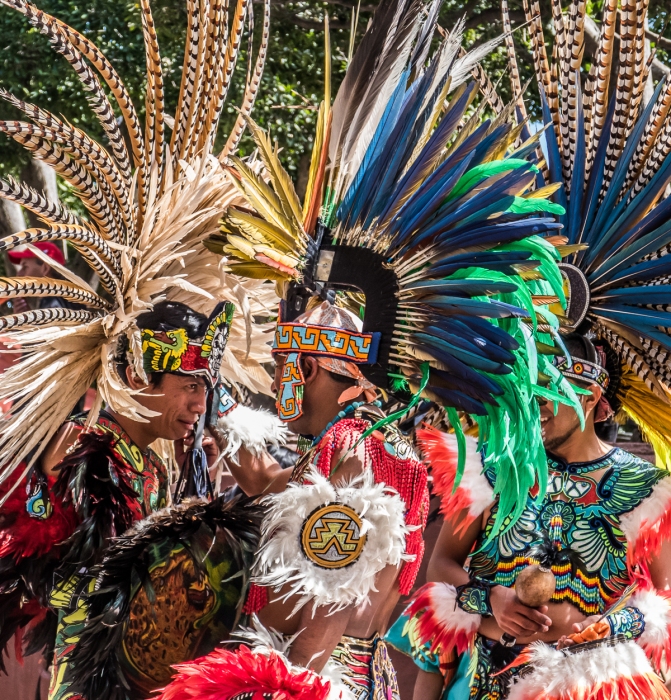
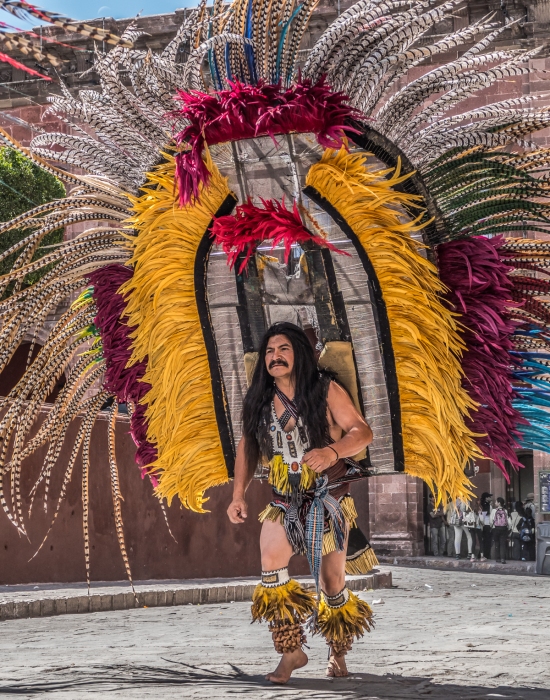

The soundscape fills the air: the pounding of drums and the ceaseless rattle of ankle bracelets made of seedpods or shells. The dancing is infectious and intense. There’s a potency to the ritual that’s impossible to ignore.
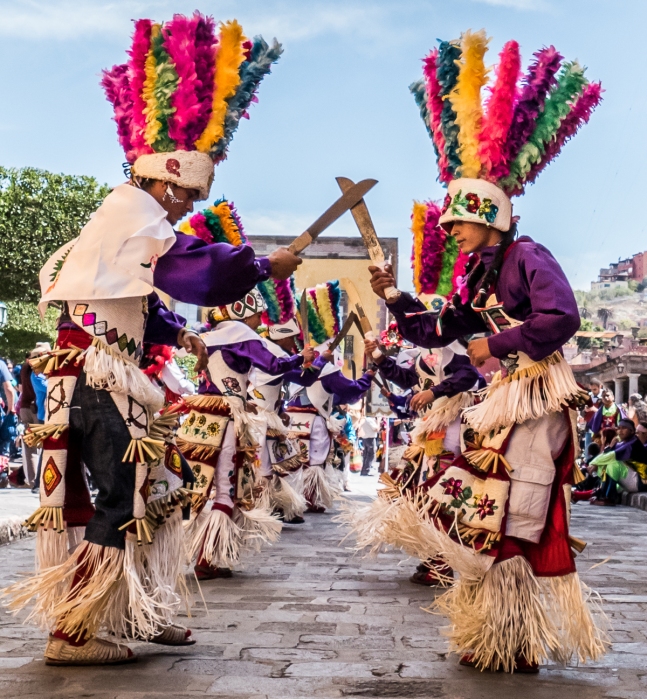
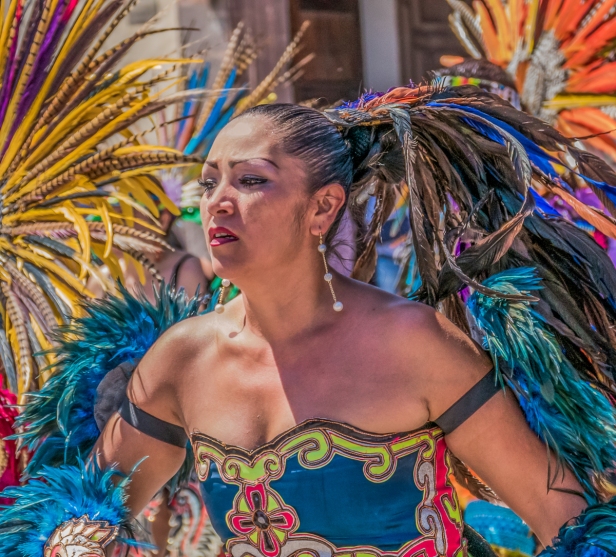
I’m fascinated by the headdresses. The more elaborate ones have bird or animal heads, or skulls. There’s a toucan head, the head of a green parrot, and a hawk, all with feathers still intact, two jaguar heads one with the pelt of the forelegs draping down either side, a wolf, a couple of foxes, many animal skulls looking ferocious with bared teeth, and several (hopefully fake) human skulls.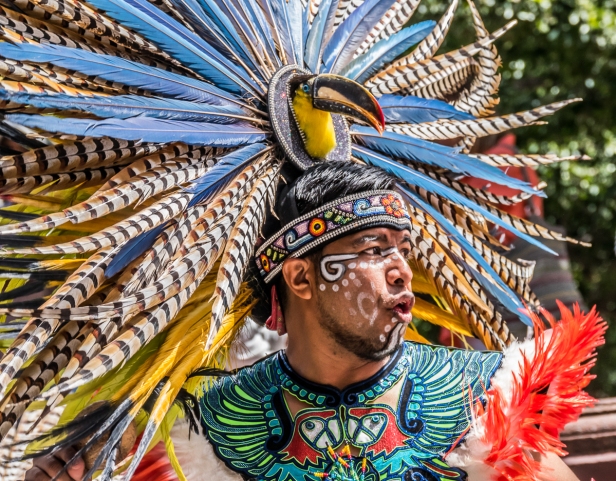
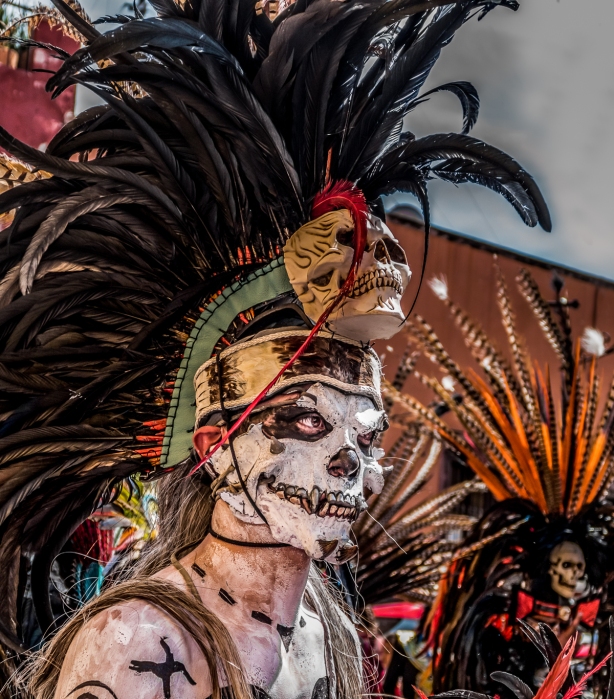
Conchero dancing began as a way to preserve the indigenous heritage after the Spanish conquest of Mexico. The dancing could not be suppressed, and eventually became incorporated into Catholic holy days. They dance in honour of Christ of the Conquest, one of the most revered statues in La Parroquia. It is the same throughout Latin America, this blending of the indigenous and Catholic traditions, rituals, and celebrations. All the dancers at some point during the day enter the church to recite thirty-three prayers, one for each year of Jesus’ life.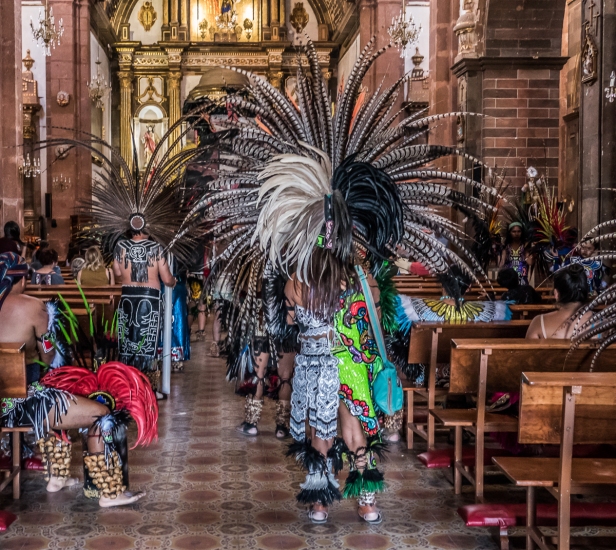
The air is thick with the smoke and smell of burning copal, tree resin that is used as ceremonial incense. Every tribe has an altar, and at each altar people, instruments, clothing, and headdresses are cleansed by the smoke.
Through the haze of smoke and feathers:
Taking a break: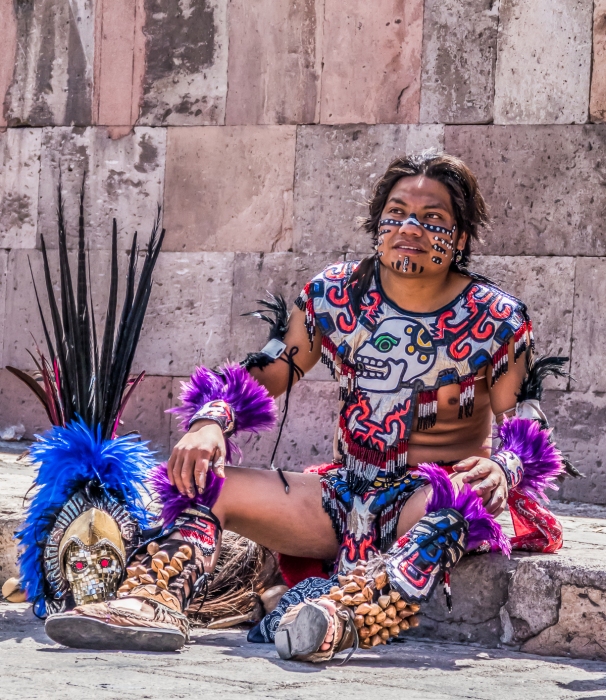


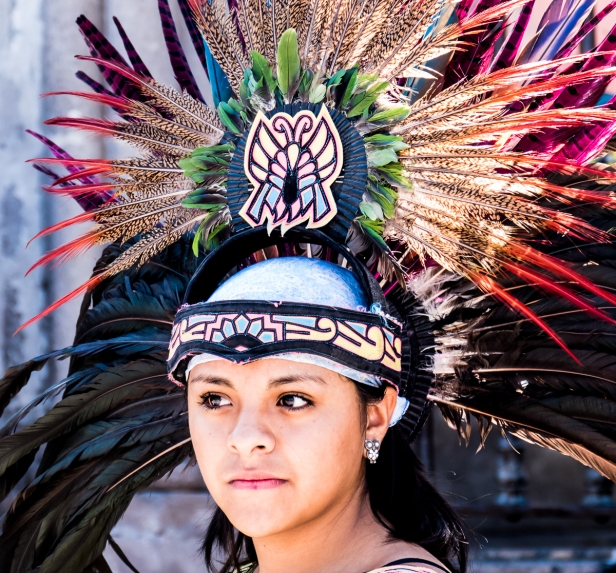
In stark contrast, the celebrations of Semana Santa (Holy Week) held during Easter are strongly Catholic. There is not a hint of indigenous influence.
His beard is grown especially for the parade. He wears a rough white tunic and rides a donkey. He is led by altar girls and boys, and is surrounded by the twelve apostles and dozens of other followers dressed as at the time of Christ. From time to time the followers shout “Viva Cristo Rey” – long live Christ King! They pass through the Jardin and on to the Church of San Francisco. While the church bells sound a clangorous welcome they file in for mass.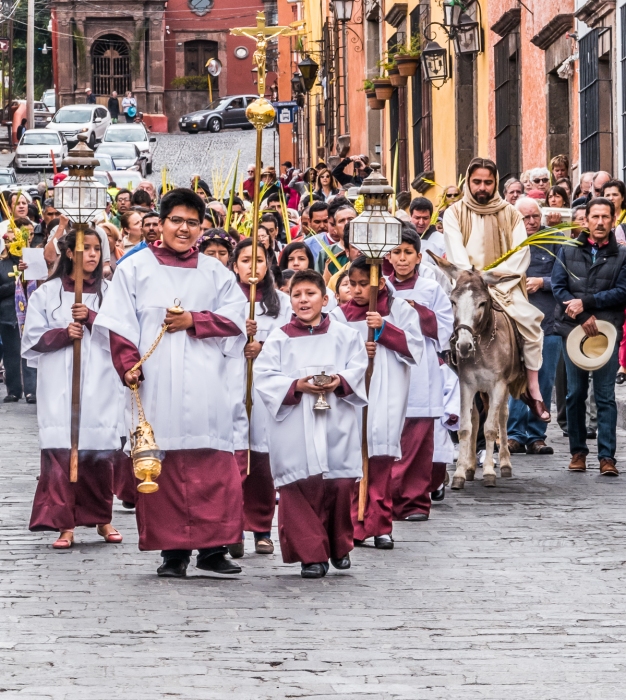
This is the first of two Palm Sunday Parades in San Miguel de Allende. The second is longer. It begins with altar boys and girls, and priests.
Then come the drummers, and the faithful carrying handcrafted palm offerings.

They are followed by four men carrying a huge statue of Christ on a donkey,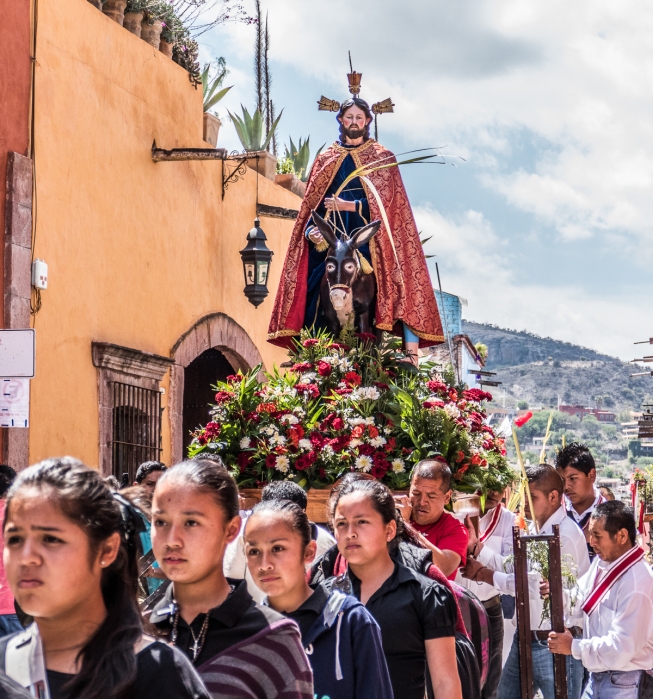
and by various community groups each carrying their own banner. More drummers and more of the faithful complete the parade. Everyone it seems wears a splash of red.
People come from all over Mexico and the world to experience Semana Santa in SMA where the final days of Christ’s life are reenacted in some detail and with great reverence. From Palm Sunday to the following Thursday there are five different parades, and on Good Friday there are three more. And of course fireworks just about every night.
Via Crucis – The Way of the Cross on Easter Wednesday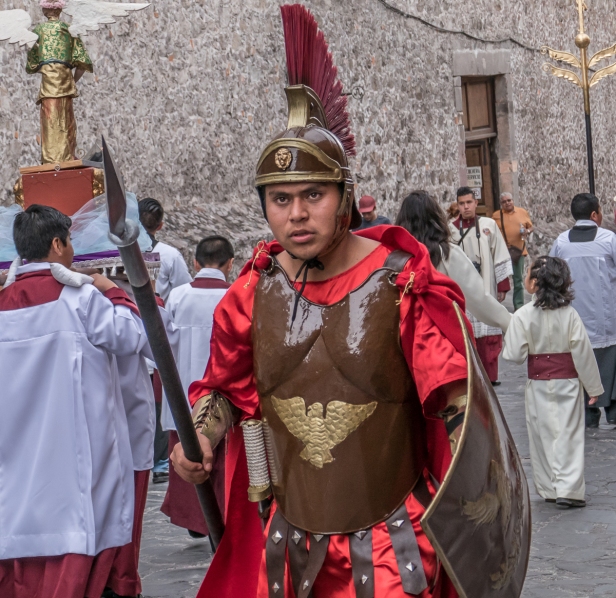
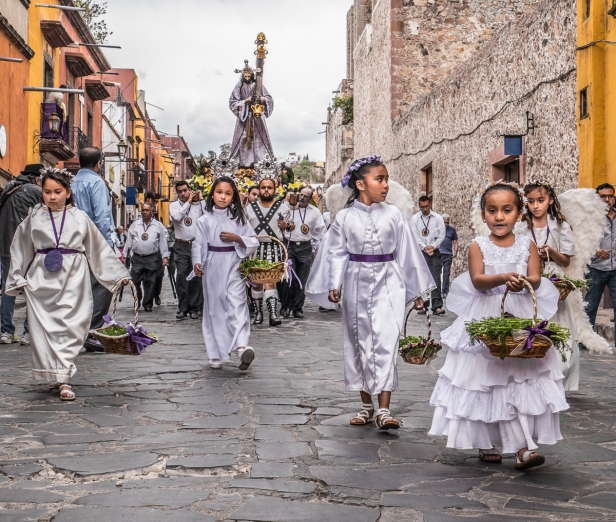
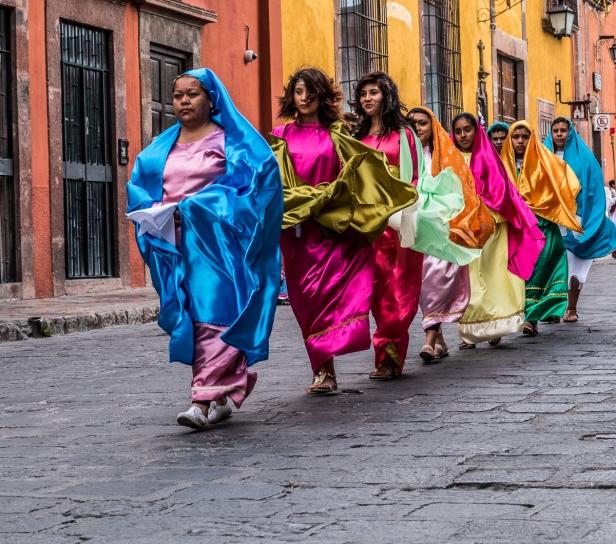
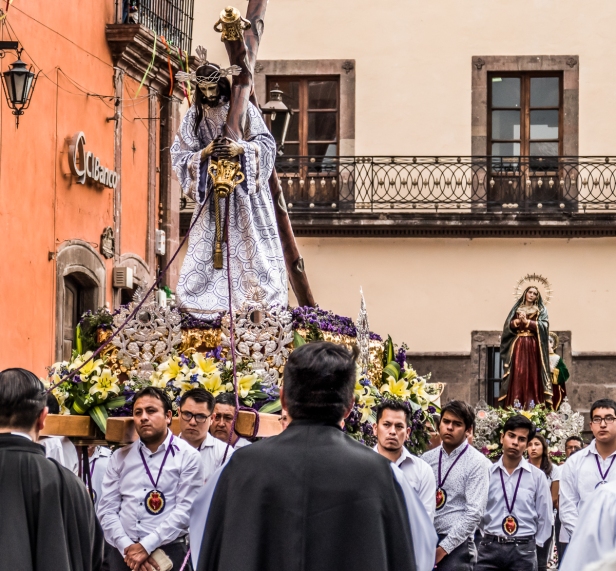
The main parade on Good Friday is the highpoint of religious observances. It begins at La Parroquia with the reenactment of the trial and sentencing of Christ by Pontius Pilot. Then the parade begins, led by Roman soldiers.
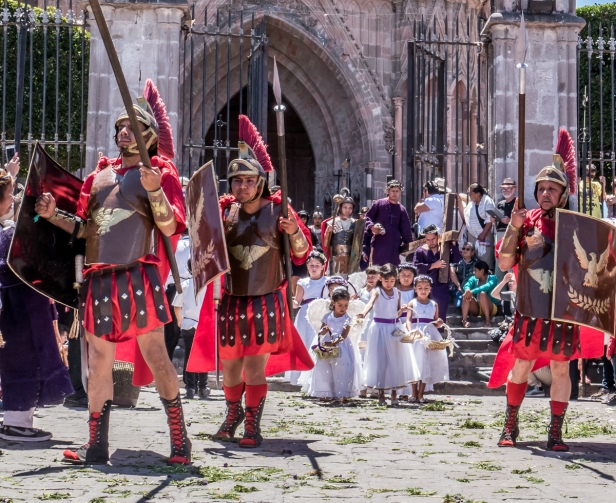
They are followed by angelitos strewing chamomile on to the pavement.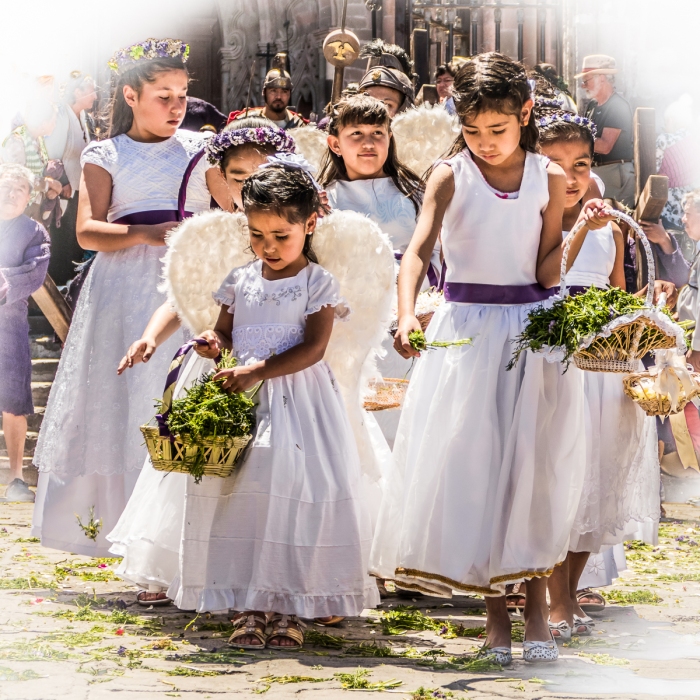
More Roman soldiers lead out two men. Each is dressed only in simple short white pants, his wrists roped to either end of rough wooden board that passes behind his back, his skin covered with “blood”. One of these men has traditionally been played by the priest since 1765. They are followed by more Roman soldiers and many penitents dressed in purple sackcloth. Each wears a crown of thorns and carries a whip and a skull. Finally another huge statue emerges from within the church. It is Christ weighted down by the heavy burden of the cross.
This is followed by about thirty children dressed in purple with an overlaying smock of white, a brass band, and three large statues of female saints including Mary. Hundreds of people take part in the parades of Semana Santa, and it is a time of great religious significance for the people of Mexico.
The parades and reenactments of Semana Santa didn’t resonate for me the way the indigenous festival did, but it was a great spectacle. What did resonate for me was the Easter Sunday explosions. It was time to burn the Judases!
I’m standing in the middle of Calle San Francisco on the north side of the Jardin. The crowds are gathered; the excitement and expectancy is palpable. In front of me there are four long ropes strung high above our heads from the building on one side of the street to the Jardin on the other. On each rope four or five life-size papier-mâché and crepe paper effigies are attached to the ropes and dangle above us. Each has a ring of fireworks around the waist.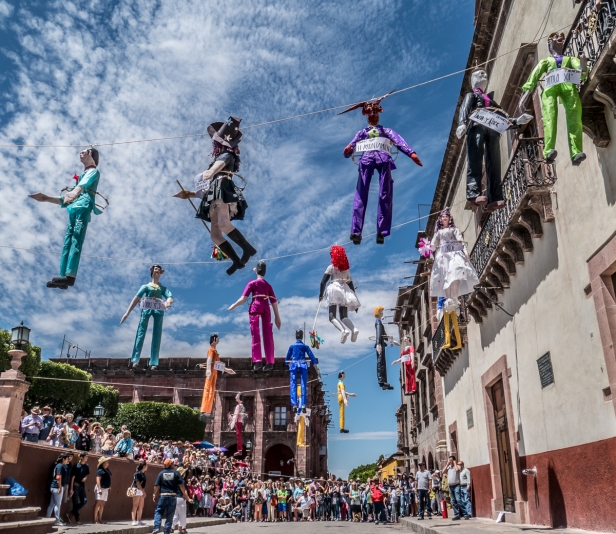
Seven or eight more rest against the wall of the building waiting their turn to be strung up. What follows is a choreographed dance as a rope is lowered, a fuse is lit, the rope is raised again, and we watch as the fuse burns down, and begins to connect with the fireworks. We all watch in anticipation, almost holding our collective breath as the effigy begins to sputter and spin in a manic dance. Suddenly it happens. The explosion! And the crowd roars its approval every time! The pieces rain down onto the street and are collected in piles. At the end there will be a great scramble for the pieces. To take home a head is a special prize.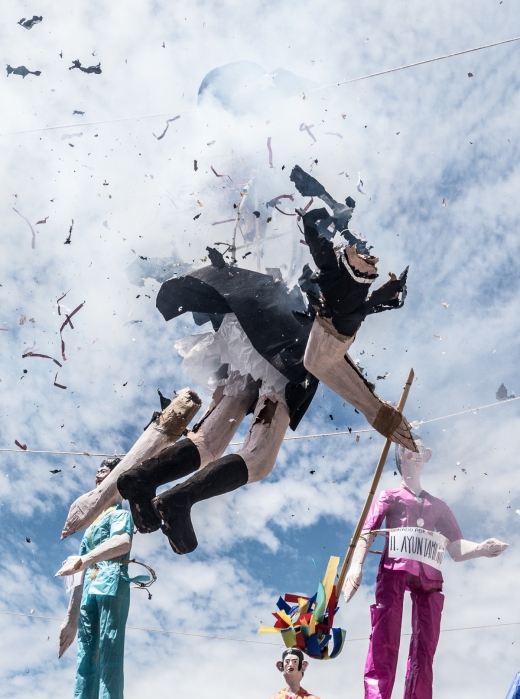
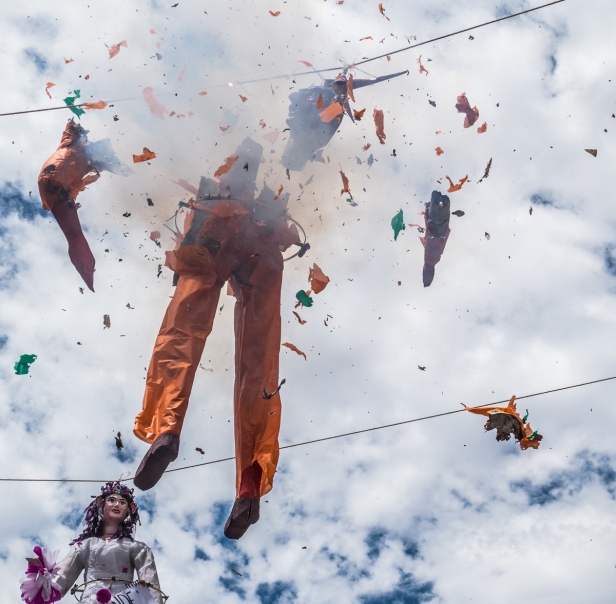
We are all waiting for Trump! We wait and wait as the other effigies are exploded. Maybe the organizers have a plan to do Trump last, but the crowd isn’t going to stand for it. By the time they have blown up about twenty the crowd waits no more. The chant starts softly at first and then quickly gets louder and louder until it is an undeniable roar: Trump Trump Trump! Trump Trump Trump! The handlers hear our plea. And the roar that goes up when Trump explodes is the loudest of all.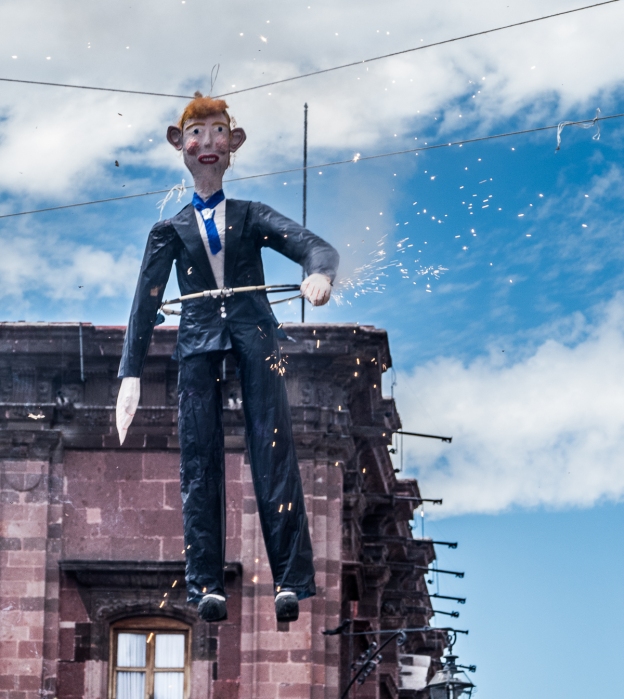
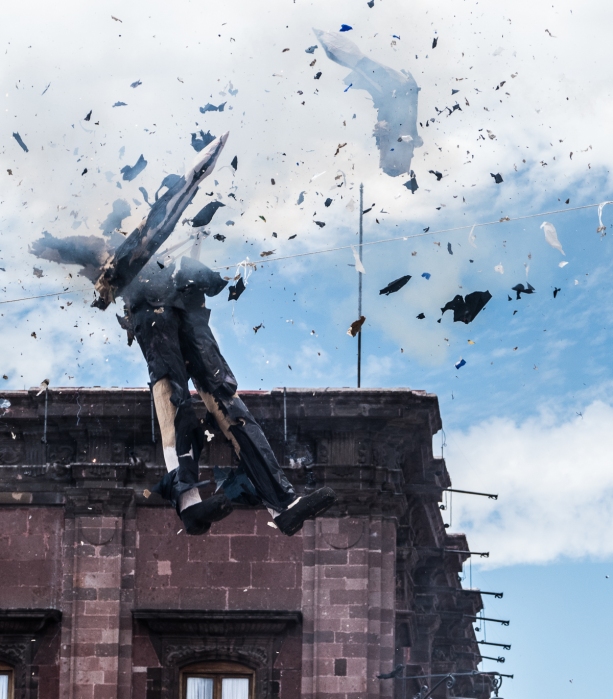
The effigies were originally meant to represent Jesus’ betrayer Judas Iscariot. The ritual began as a cautionary tale to the masses demonstrating what happens to you when you commit a sin. It was brought by the Spanish to the new world and was part of their efforts to convert the indigenous population. These days the effigies are more often comical characters or unpopular politicians.
And so on this riotous note more than a week of Semana Santa celebrations and rituals comes to an end.
Of course we find the best ice cream in town. Way down Zacateros, after it becomes Ancha de San Antonio, is Helados Santa Clara, serving ice cream and coffee. We’re there frequently and sink with our drippy sweet treats into the soft chairs in a dim corner way in back. I notice the photographs on the walls. They are of SMA streets, and they capture the feel of the old town with a silky depth. One in particular catches my eye. I want to see that street! I want to be there at sunset to get that same photograph!
Don goes on a scouting mission while I’m at home all wrapped up in pain. He announces he’s found a street near the Jardin that could be it. It’s important that there are no cars. So next evening I get a taxi there and get my shot. I know it’s not the same street, but it’s close enough. It has the atavistic feel and colour of SMA in the fading evening light.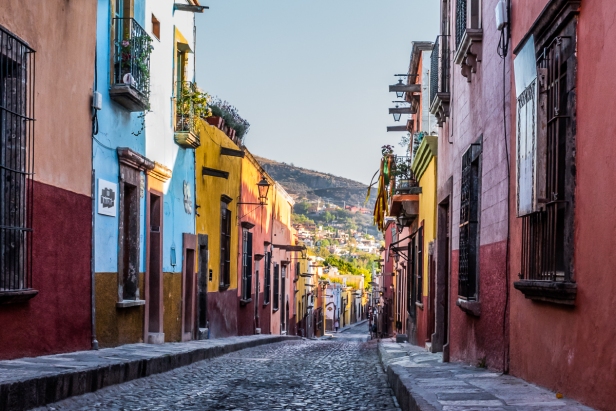
Next time we are at Helados Santa Clara I’m looking at the photographs on the walls and some people sitting near us mention the name of the artist. They’re paintings! Later I go online and look at more of his work. It’s beautiful; I love it. I don’t remember his name. And we might never have found the street in his painting since it possibly doesn’t even exist, but what wonderful inspiration it proved to be.
Spring arrives, proclaimed by the jacarandas blooming purple all over town. We’d originally planned to spend five months in SMA, but after three months finally both of us are ready to go La Manzanilla. For our last night in town we go to the very swish Luna Rooftop Tapas Bar at the Rosewood Hotel. We eat in slow stages, enjoying the sheer luxury of the setting, and looking out over the magnificent views of San Miguel at sunset. Suddenly, as we’re about to leave, I see the city in whole new light.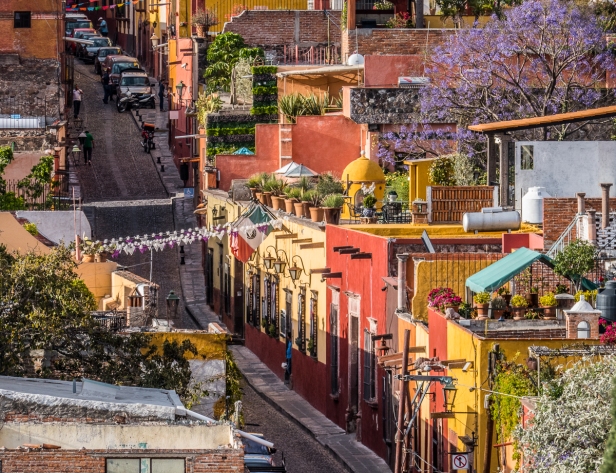
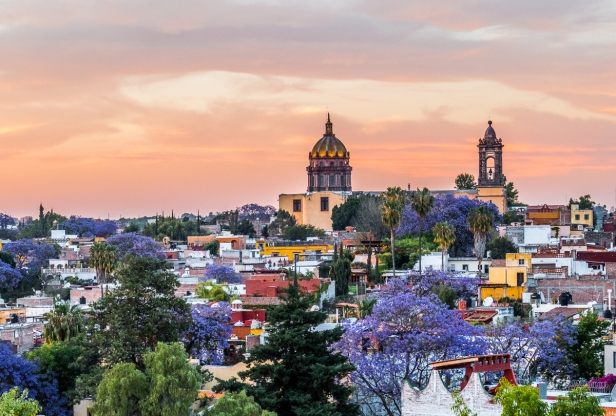

Next post: SMA WTF!
All words and images by Alison Louise Armstrong unless otherwise noted © Alison Louise Armstrong and Adventures in Wonderland – a pilgrimage of the heart, 2010-2016.

visual explosion
of those here
in joyful humility
celebrating death 🙂
LikeLiked by 1 person
Oh yes! Visual explosion
exploding in my heart
the joy of celebration and surrender.
Alison
LikeLiked by 1 person
I love, love, love these photos, but especially the one of you ‘kissed by death’ and your comment, a benediction not an omen. What incredible sights. Brings back happy memories of our stay there three years ago.
LikeLiked by 1 person
Thank you so much Helga. Being kissed by death was a special moment. Somehow we connected. Happy to bring back happy memories for you. It’s a wonderful place.
Alison
LikeLike
Amazing post and absolutely stunning photography! Bravo – you captured the colour, excitement and the mood so well. Tim
LikeLiked by 1 person
Thanks so much Tim. Their festivals are so full on, and they use so much colour, even in the more solemn parades. It was magical.
Alison
LikeLike
I so love Mexico and this post perfectly captures why! Beautiful~
LikeLiked by 1 person
Thanks Cindy. I love Mexico too. Headed back in only 9 days. Yay!
Alison
LikeLike
Incredible post. The town has such a complementary color palette — lots of purple and gold. Beautiful! Love the indigenous festival photos, in particular, and that fearless kiss from death!
LikeLiked by 2 people
Thanks Kelly. It’s such a beautiful town! Especially when the jacaranda are in bloom. They pronounce if hacaranda of course. That indigenous festival was wild! Sooo exciting! And the kiss of death was the cherry on top.
Alison
LikeLike
Amazing photos! Wonderful narrative. Thank you
LikeLiked by 1 person
Thanks so much Donna. Glad you enjoyed it.
Alison
LikeLike
Wow, the colors! Amazing!! Felt I was watching the festival just in front of me.
LikeLiked by 1 person
Thank you Chiaki. Arigatōgo and Xièxiè! I’m glad you felt like you were there – it’s the best compliment.
Alison
LikeLiked by 1 person
How colourful. I could look at those pictures for hours. Here in Spain Easter is a huge celebration as well with many fiestas and parades.
LikeLiked by 1 person
Thanks Darlene. It was fabulous to watch it all, especially the Indian celebrations. I can imagine there are amazing fiestas and parades in Spain. I think a lot of what we see in Mexico either came from Spain, or has Spanish influence – so bold and colourful.
Alison
LikeLike
I believe you are right. The Indian celebrations would be unique to the area, though. Lucky you to have witnessed it.
LikeLiked by 1 person
Really enjoyed your travels as usual. Should the date at the top be 2016?
LikeLiked by 1 person
Thanks Michelle. And yes, thanks! The date should be 2016. We both missed it. I think I’ve barely gotten used to 2016 and it’s going to change soon.
Alison
LikeLike
Great post as always. I loved your interaction with the guy in the death mask and his tassel now on your camera case. And the kiss and the photo of the two of you, how special. Glad Don found the street for you. The feature photo is stunning with the beautiful light. I just love the exploding effigies. Thanks again Alison for sharing your travel stories of a place I had never heard of. Louise
LikeLiked by 1 person
Thanks Louise. I was a bit worried about the tassel feathers, but I got them into Canada with no problem. Now I have to get them back into Mexico, and then Cuba, Guatemala, etc. I hope they don’t prove to be too much of a tassel hassle when crossing borders. It was a really lovely connection with that death guy.
The exploding effigies were awesome! And we watched 24 of them!
Alison
LikeLiked by 1 person
… and you managed to capture it in the photos! Louise
LikeLiked by 1 person
Mexico is one huge glaring hole in my travel history and one I really need to correct properly. Your photos and description make it look absolutely incredible. And what a contrast between the different celebrations! With the exploding Trump the perfect exclamation mark on everything. Hahaha.
LikeLiked by 1 person
Thanks Shelley. Believe me Mexico is absolutely incredible! And the variety of fiestas amazing. We went to one that lasted for 2 weeks in Oaxaca a couple of years ago. It was spectacular in every way. Here’s a link to one of the four posts about that festival:
I really recommend Mexico. We’ve also spent time at the beach there – in La Manzanilla, and on the Baja.
Alison
LikeLike
Like Shelly, despite all the places I’ve been Mexico isn’t on the list. Clearly I’ve missed out. I doubt I could capture the beauty as well as you have.
LikeLiked by 1 person
Thanks Dave. Get Mexico on your list! It’s an amazing country with a great variety of landscapes, endless colourful festivals, fabulous beaches, and incredibly friendly people.
Alison
LikeLike
You know what it’s good about reading an article instead of book? It is like a daily espresso shot or Sun Salutation yoga flow in the morning. It awakes your soul and let it mingle with your mind, which creats a great attitude for the day then. It is like an inspirational quote instead of a long journey. Thank you, Alison, for that !
By the way, the picture of church with blooming jacarandas and sunset is my favorite, it’s magical!
LikeLiked by 1 person
Thank you so much. What a lovely way to see it – a shot of espresso or a good yoga flow. I like that. I love that shot of the church with the jacarandas, and the others I took that evening – it was a whole different view of SMA for me, and such beautiful evening light.
Alison
LikeLike
Wow- those costumes, those photos, those fierce expressions, those angle wings on a child, and those exploding paper mache dolls! …Again, wow.
LikeLiked by 1 person
Thanks TSMS. It was amazing! All of it! And to have it finish with the exploding effigies was just spectacular.
Alison
LikeLiked by 1 person
It’s always fascinating to see how in some parts of the world new religions have been absorbed by the local people without eliminating aspects of indigenous cultures. Enriching, not replacing, seems to be the best way for any religion to survive the test of time and coexist peacefully with other beliefs.
I love how you captured the emotion, movements, and colors of the entire festival, Alison. And that Trump effigy… I love the sense of humor of the local residents. 🙂
LikeLiked by 1 person
Thanks Bama. It was amazing photographing the festivals, trying to get everything, but not succeeding of course since there was so much going on.
I found throughout Latin America the blending of the original native spirituality with Catholicism. From memory I think it was most evident in the Andean countries. And in ancient Egypt it was the same – when the Greco-Roman rulers took over they presented themselves as pharaohs and allowed the population to continue with their own spiritual practices despite Roma having already being converted to Christianity. It seems a much more subtle and successful way to do it – people always come around eventually. They certainly did in Latin America, and in Egypt of course it was the Ottomans who brought Islam that was the stronger influence, and the old ways gradually fell away.
People, Mexicans and foreigners alike, were very excited to blow up Trump 🙂
Alison
LikeLike
What glorious photos–so full of color and warmth and passion! I loved the benediction from death and think we would do well to make peace that chrome Vader visage, who spins the wheel and ushers in the new! And so many beautiful faces here! So many worlds colliding. I like the crisp image of the man in a silver dress shirt out in front of the red and white robed altar boys. And the one barefoot dancer wearing some sort of regalia that was about twelve feet tall! Everyone I saw looked like the World’s Most Interesting Persona! Ha!
Peace
Michael
LikeLiked by 1 person
Thank you Michael. It was all such a treat to see and to photograph! And the benediction from Death an unexpected and sweet encounter. I was slack-jawed at that feathered regalia barefoot-man was wearing. I think it was the biggest of all, though there were certainly others as spectacular, and nearly as big, but I didn’t manage to get good photos of them.
Alison
LikeLiked by 1 person
An event and city beautifully captured! The rich colors in every shot, the movement of the dancers…. wow. Thanks for sharing your experience
LikeLiked by 1 person
Thanks so much Andie. It was a pretty awesome experience. I’m glad I managed to capture something of it. Mexico’s amazing for these kinds of events.
Alison
LikeLike
When I read your posts and look at your photos, I sometimes wonder if I have ever really SEEN some of these things before?! I’ve been to SMA, all over Mexico actually, have seen religious parades and celebrations, photographed street scenes – yet never have I really seen the riot of color and action and emotion you seem to capture when you lift your camera to your eyes! Such a treat to see the world through your lens(es).
I have to say the exploding Trump was like a dream comes true … hoping he has exploded himself enough in recent weeks to kill his chances here. Your closing thoughts that you finally see the city in a new light on the cusp of your departure are not surprising to me. Psychologically, I think that when we are finally free of a place or thing that was difficult for us, we look back more fondly and say “hey, I kind of liked that after all!
LikeLiked by 1 person
Thank you so much Lex. This is a wonderful compliment and I am honoured. I must say though that I sometimes have that same feeling myself when I see photographs of places I’ve been too. How did I miss that? I think to myself. Exploding Trump was awesome! Our last evening in SMA was helped by the fact that we went at sunset to the fanciest rooftop restaurant in town. A little luxury never hurt anyone and the view was spectacular, though I take your point – I was there with the freedom of knowing I was finally leaving the next morning which I’m sure must have had something to do with my mood.
Alison
LikeLike
Exploding Trump! Love it. Your photos are awesome and this reminds me why I declared Mexico my favorite country last year – It is so vibrant and I don’t think most people have a clue about all this rich culture. We think of beaches and crime, but not this. Thanks for sharing.
LikeLiked by 1 person
Thanks Jeff, and yes isn’t Mexico fabulous?! I don’t know why it gets such bad press. Everytime/everywhere we’ve been there we’ve loved it.
Alison
LikeLiked by 1 person
Wow, those are some costumes! This post is just stimulus overload (in a good way). And exploding Trump…icing on the cake. The blooming jacaranda tree photos are stunning.
LikeLiked by 1 person
Thanks Caroline. I guess it was easier for me since there was about three weeks between the two festivals – so a break from stimulus overload. Exploding Trump was fantastic! I was not remotely expecting that. When I arrived that morning all the effigies were lined up against the wall and I had no idea that one of them was Trump. I only found out as things got going. And the jacarandas! So beautiful. I could hardly believe it when suddenly they started blooming all over town.
Alison
LikeLike
This post, your words, your fabulous photographs made both Terry and I want to catch a flight to SMA. I am already thinking about a visit during Semana Santa. I remember how moving the experience when we were in San Antonio Tlayacapan during Semana Santa. I particularly like the photo of you being kissed by ‘Death’. I would love to see the indigenous dancers perform. Another amazing post Alison!
LikeLiked by 1 person
Thanks so much LuAnn. You could maybe combine both celebrations if you want to spend a month in SMA. The Festival of Our Lord of the Conquest is held the first Friday in March, and Semana Santa is Easter of course, which this year was late March. That whole interaction with “Death” was unexpected and really sweet. And the indigenous dancers are *amazing!* My photos only show a glimpse of it.
Alison
LikeLiked by 1 person
Unexpected but not a coincidence that you were chosen. 😉 We saw a performance one night at La Parroquia which was amazing but nothing like the indigenous dancers.
LikeLiked by 1 person
They exploded Trump, and then Hillary Clinton did. Yes!!
When we lived in Nicaragua semana santa was always chockfull of parades and festivities but nothing as elaborate as this. As I scan your beautiful photographs it makes me wish and rethink the fact that I use an ipad for photography, ( many readons for this…) rather than a “real”camera.
We will have to get to SMA one day!
Peta
LikeLiked by 1 person
Thanks Peta. Semana Santa in Nicaragua sounds wonderful. I think it’s pretty special throughout Latin America but I had read that SMA is probably the best of the best. Glad we were there to see it. We carry laptops and cameras. It’s a lot in weight but since we don’t have a home anywhere we must carry it with us. And I simply can’t imagine being with a camera – photography is one of the great loves of my nomadic life. Also I couldn’t do the photo editing that I do on an iPad, and the editing is more than fifty percent of what makes the photos. Hope you get to SMA. It’s a really special place.
Alison
LikeLike
What an explosion of colour and emotion and unbridled joy! And how well you portray it Alison. Your photography gets better by the day. Now I want to witness all of this for myself. Hopefully, they will not need a Trump effigy by the time I get there. Fingers crossed for both: my visit and for America 🙂
LikeLiked by 1 person
Thanks so much Madhu. It was all that! – an explosion of colour, emotion, and unbridled joy. I’m glad I managed to convey that. Both festivals were exciting in their own different ways. So colourful – even the solemn parades. Are you off to America? Yes, hopefully there’ll be no more need for exploding Trump effigies.
Alison
LikeLike
Your photos of the jacarandas and description of SMA’s Semana Santa rituals reminded me of one of our (hands down!) favorite experience during our travels in Central America. We arrived in Antigua, Guatemala during Lent and watched 4 weeks of incredible processions that culminated in the crucifixion on Friday when all the marchers donned black clothing at 3 pm. I’ve always loved your photos and the descriptions of various celebrations throughout your travels, Alison, and this post is no wonderful. You’ve captured so much color and sheer energy! And what perfect timing of your story of the exploding effigy of Trump! 😀 Anita
LikeLiked by 1 person
Thanks so much Anita. That must have been amazing in Antigua. I’ve heard Antigua is a far more attractive city that Guatemala City. We’re planning on going to Guat this winter. We have friends who live in a village there and hope to catch up with them as well as explore the country a bit. I’ll be sure to check through your posts about it. Loved the exploding Trump 🙂
Alison
LikeLike
Well that’s a heck of a lead-in to your next post! 😉 I really enjoyed the descriptions of the Easter festival. It’s one of my least favorite Christian holidays, but it the ritual and ceremony of it are certainly something that speak to all of us, I think. And definitely way more flamboyant that my Midwest upbringing can fathom!
LikeLiked by 1 person
Thanks Felicity. The Easter celebrations, as you can see, are really huge in SMA, probably more so than anywhere else in Mexico. Many Mexicans travel to SMA for Semana Santa because of the elaborate rituals there. It was great to see it all unfold. I’m not religious but I did enjoy the spectacle of it and appreciated their devotion. The Indian festival was much more my style 🙂
Alison
LikeLike
Incredible pictures as always Alison and I especially like the exploding Trump! Arghhh I can’t stand that man so you made me laugh! 🙂
LikeLiked by 1 person
Thanks Nicole. Exploding Trump was a riot. A huge roar of approval went up from the crowd when it exploded. Glad I made you laugh 🙂
Alison
LikeLiked by 1 person
Fantastic photos
LikeLiked by 1 person
Thanks so much. I’m glad you like them. And thanks for commenting.
Alison
LikeLike
I could feel the rhythm,energy ,joy and colors.The rituals are so fascinating.You are blessed,Alison.
LikeLiked by 1 person
Thanks so much Sidran. It was all so wonderful, and exciting! Yes, we are very blessed. And very grateful.
Blessings, Alison
LikeLike
A ‘cautionary tale’ to Trump?? Ah the world wishes and how amazing to see his effigy blown up! 🙂 As always such stunning photography…. so rich in colour, stories, insights.
LikeLiked by 1 person
Thanks Carissa. Everywhere we’ve been in Mexico there’s been this incredible richness of colour and festivities and warm friendly people. Exploding Trump was a riot!
Alison
LikeLike
Your stories and photographs bring back so many memories. Thank you x. I hope you don’t mind but I mentioned you on one of our articles, so our readers could too enjoy your posts.
LikeLike
I promise I wasn’t ignoring you! I just found your comment in the spam folder. Who knows why. WP can be funny sometimes. I’m glad this post brings back some good memories for you, and I’m honoured and delighted that you mention me in one of your articles. Thank you so much. Hope you’re enjoying Greece. We’re back in the Mexican heat and loving it.
Alison
LikeLiked by 1 person
Fantastic photography! I struggle with portraits and as a result I often hide behind a wide angle lens and photograph landscapes instead. These inspire me to take my camera to the streets and engage more with people. Thank you 🙂
LikeLiked by 1 person
Continuing our conversation from your blog I’m thinking this must be Verne, right?
Anyway thank you so much. I used to be afraid of photographing people, and have been stopped a couple of times, but I’m braver now. People in India *love* to be photographed, and ask for it. Mexicans always respond well. I mostly engage with the people though not always. Right now I can’t think of anywhere I’ve been where it was really a problem, though I confess I often use a long lens and sometimes hide behind Don to get the shot. It’s the people that make a place come alive for me. At the same time I wish I was better at landscapes. Always learning.
Alison
LikeLike
Yes, Verne here (it’s probably time we figure out how to create two separate usernames). Sound advice, I’ll give it my best shot (and take Jules along, so I can hide behind her if needed)! For landscapes, the step change for me was when I got a 16mm lens, as the wide field of view accentuates perspective lines and helps to draw attention to a specific part of the frame.
LikeLiked by 1 person
Stunning shots which made me feel as if I were there. You have described the scenes so well, thank you so much for sharing part of a difficult time.
LikeLiked by 1 person
Thanks so much Debbie. Both festivals were pretty amazing and helped me forget my troubles for a while. It always amazes me how the pain can disappear when I’m completely engaged in something. I’m learning a lot about the nature of pain.
Alison
LikeLiked by 1 person
So much energy, and some compelling faces, in the indigenous festival, Alison. 🙂 I find it rather moving that in the midst of this they go and say prayers for Christ. Such a colourful way of life compared to our grey old Britain. 🙂
LikeLiked by 1 person
The Indian festival was truly amazing. I’d read a little bit about it, and maybe seen a picture or two, but nothing really prepared me for the reality. Hundreds of them! Dancing on and off for nearly all the day. The energy and community spirit was incredible. Everywhere we’ve been in Mexico we’ve seen this colourful way of life, and in South America too. Christianity was accepted by the Indian populations but without erasing their own spiritual traditions. It’s a unique and rich blending of two vastly different cultures.
Alison
LikeLiked by 1 person
I appreciate your keen interest and artistic mind to capture the essence of the whole scene..:)
LikeLiked by 1 person
Thanks so much. I love to photograph events like this – so much colour and vibrant life!
Alison
LikeLike
WOW – so wild and colourful. Your photos look different – do you have a new camera Alison? So vivid and sharply detailed…
LikeLiked by 1 person
Thanks Shirley. It was amazing. Mexico really knows how to do festivals! I got a new camera about 2 years ago. I quite like it but am aware of its limitations. I’ll get another upgrade eventually. I know a lot more about post editing now that I used to so perhaps it’s that.
Alison
LikeLike
You had me at Exploding Trump – ha! I really enjoyed this post – it reminded me of our trip early this year to Barranquilla for Colombia’s Carnival. Sadly, parades like this may be a thing of the past, at least for the next few years. But let’s hope they keep blowing up Trump effigies 🙂
LikeLiked by 1 person
Thanks so much Susan. Glad you enjoyed it. It was so much fun to be there. Mexico, and South America too, do such fabulous festivals. We went to a huge one in Oaxaca, and another in Puno, Peru. But, sadly, yes it may be a while before they happen again 😦
Re the other – yes!
Alison
LikeLiked by 1 person